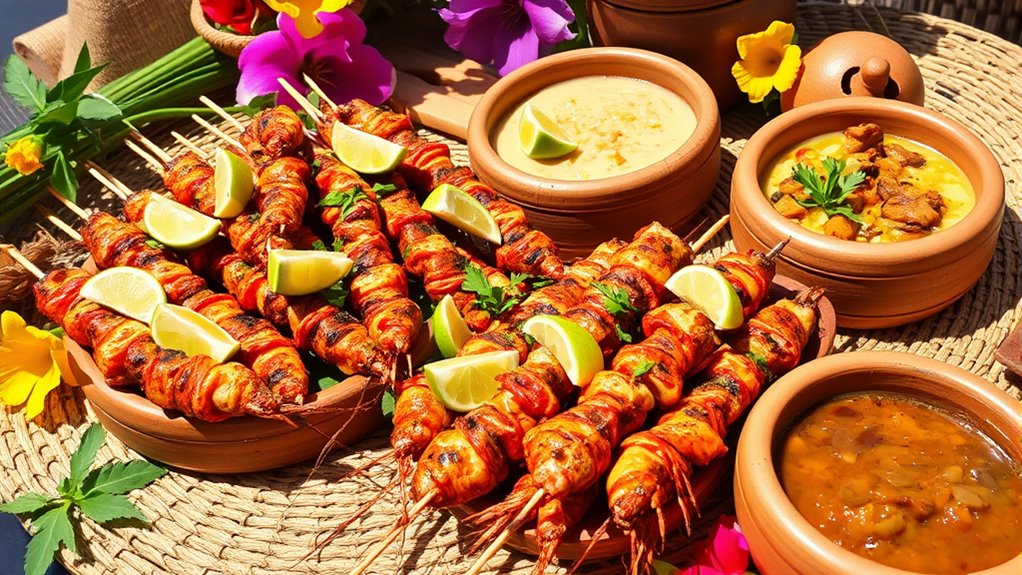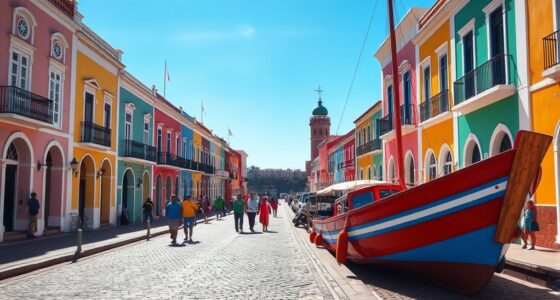Curaçao’s cuisine reflects a lively mix of Caribbean, Dutch, Latin American, African, Asian, and Indigenous influences. You’ll find hearty dishes like Keshi Yena, fresh seafood, and comforting staples like Funchi and Tutu, often served at markets and family gatherings. Vibrant street food, celebrations, and modern fusion dishes showcase its multicultural spirit. Explore how history, culture, and craftsmanship come together in every bite—you’ll discover more about this colorful culinary tapestry as you continue.
Key Takeaways
- Curaçao’s cuisine reflects a multicultural blend of Caribbean, Dutch, Latin American, African, Asian, and Indigenous influences.
- Iconic dishes like Keshi Yena and seafood specialties showcase the island’s cultural fusion and coastal heritage.
- Markets, street food, and community eateries serve traditional foods such as Funchi, Tutu, and pastechi, emphasizing local ingredients.
- Papiamentu language and cultural celebrations play a vital role in preserving and expressing culinary heritage.
- Food and craftsmanship, including crochet decor, intertwine to celebrate cultural identity and community traditions.
The Melting Pot: Cultural Influences Shaping Curaçaoan Cuisine
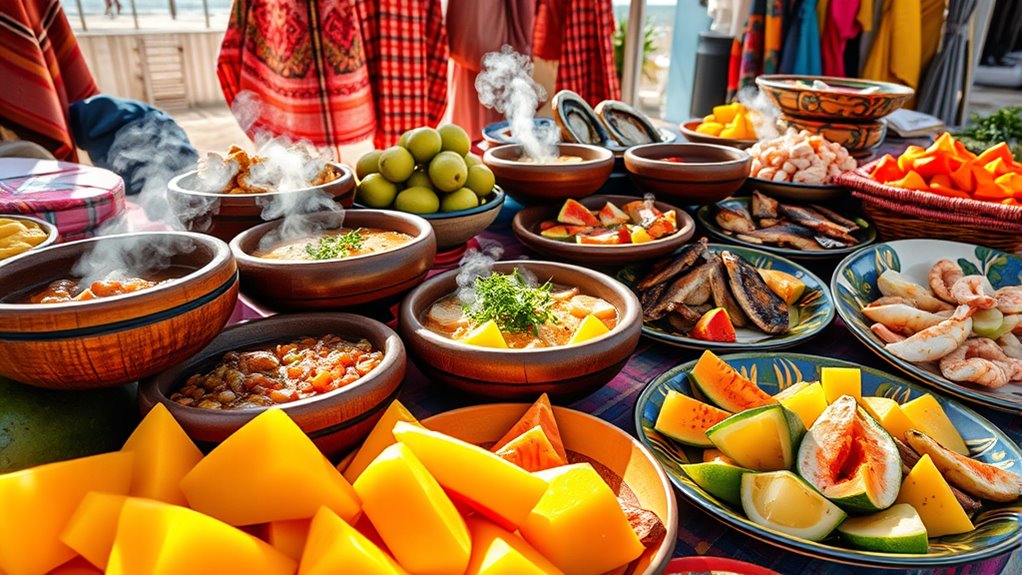
Curaçaoan cuisine is a vibrant reflection of its complex history, shaped by a diverse array of cultural influences that have blended over centuries. You’ll notice African, Dutch, Caribbean, Latin American, Asian, and indigenous Arawak elements in every bite. African traditions bring bold spices and hearty stews like Kabritu Stoba and Funchi, while Dutch colonization introduces dishes like Keshi Yena, a cheese-filled baked delight. Latin American immigrants add ingredients like pumpkin for Arepa di Pampuna and bring fresh produce via the Floating Market. Asian influences, though subtler, contribute spices and techniques from Indonesian and East Asian cuisines. Together, these influences create a unique, multicultural culinary tapestry that defines Curaçao’s flavor profile and culinary identity.
Iconic Dishes That Define the Island’s Culinary Identity
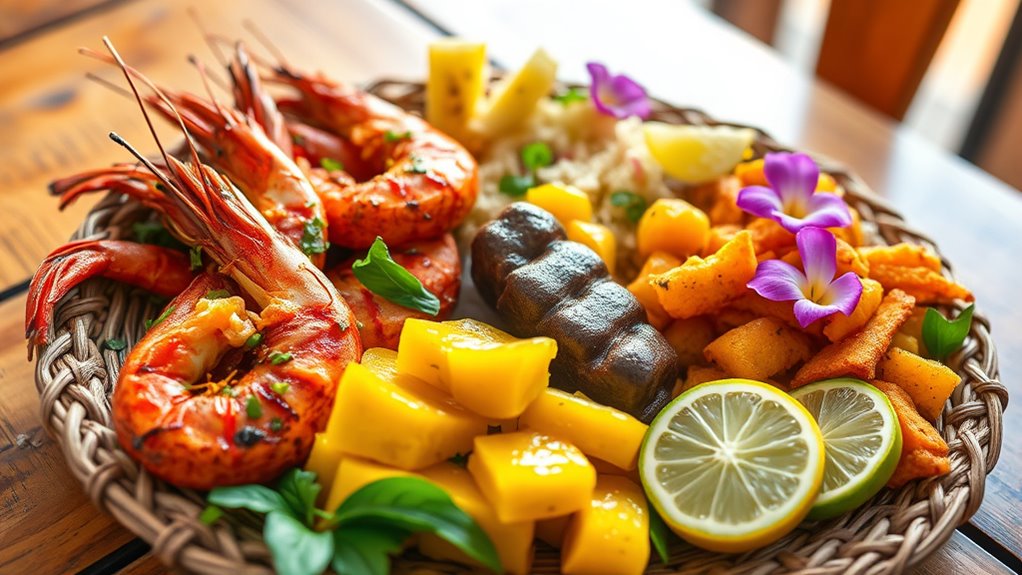
You’ll find that Keshi Yena exemplifies Curaçao’s rich cultural fusion, combining Dutch, African, and local flavors in a single dish. Traditional seafood delights highlight the island’s access to fresh fish and tropical ingredients, reflecting its coastal heritage. Hearty cornmeal dishes like Funchi and Tutu complete the culinary picture, offering comforting staples that connect generations. Additionally, the use of plant-based ingredients in local cuisine showcases the island’s adaptation of diverse culinary influences.
Keshi Yena’s Cultural Fusion
Keshi Yena exemplifies the rich cultural fusion that defines Curaçao’s culinary identity. This dish combines Dutch, African, and Caribbean influences, highlighting the island’s diverse heritage. You start with a hollowed-out Edam cheese, a symbol of European roots, filled with spiced meat, olives, and raisins—ingredients reflecting local flavors and trade connections. The dish’s hearty nature showcases African-style seasoning and Caribbean tropical ingredients, creating a balanced, flavorful profile. Baked until bubbly, Keshi Yena embodies the island’s culinary blending, where European techniques meet African spices and Caribbean produce. It’s more than just a dish; it’s a cultural expression that celebrates Curaçao’s history of migration, trade, and adaptation, making it a true icon of the island’s culinary soul. The fusion of flavors in Keshi Yena highlights the island’s complex cultural history and diverse influences.
Traditional Seafood Delights
Seafood plays a central role in shaping Curaçao’s culinary identity, offering a vibrant showcase of the island’s rich maritime resources. You’ll find that fresh fish, lobster, and shellfish feature prominently in local dishes. Sopi di Piska, a flavorful fish soup made with fresh catch, coconut milk, and local spices, highlights the island’s love for seafood. Fish is often grilled or baked with tropical herbs, enhancing its natural flavors. You might also enjoy seafood fritters or ceviche, reflecting Caribbean influences. These dishes emphasize simplicity and freshness, showcasing the bounty of Curaçao’s waters. Seafood’s integral role connects to the island’s maritime traditions, making it a staple in daily meals and festive gatherings alike. The vibrant flavors and fresh ingredients define Curaçao’s seafood delights. Vetted seafood options ensure that the freshness and quality of ingredients are maintained, which is essential for authentic and safe culinary experiences.
Hearty Cornmeal Dishes
Cornmeal dishes are at the heart of Curaçao’s culinary traditions, serving as comforting staples that reflect the island’s resourcefulness and rich cultural history. Funchi, a thick cornmeal porridge, is a versatile side often served with stews or fried fish, embodying African influences. Tutu, another cornmeal-based dish, combines black-eyed peas with spices, adding depth to meals. These hearty dishes highlight local ingredients like cornmeal and tropical spices, showcasing a mix of African, Caribbean, and Dutch flavors. You’ll find them featured in everyday meals and celebrations alike. Their simplicity and warmth connect generations, preserving Curaçao’s culinary identity. Whether served at market stalls or family tables, these cornmeal dishes symbolize the island’s resilience and vibrant cultural tapestry.
Key Ingredients and Flavor Combinations Unique to Curaçao
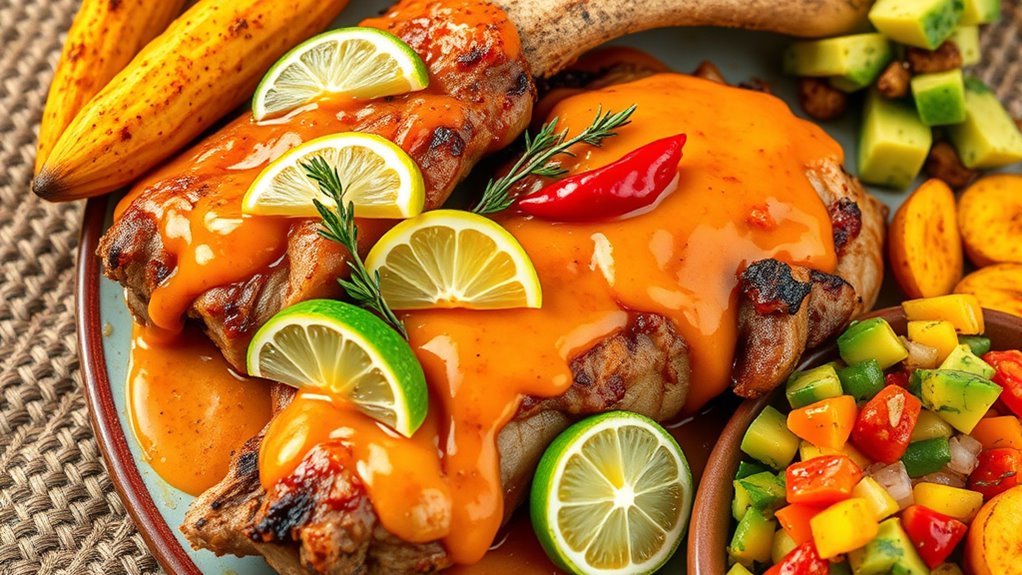
You’ll notice that Curaçao’s cuisine highlights vibrant tropical fruits like mango, papaya, and pineapple, which add fresh, sweet flavors. These fruits often pair with bold spices and local ingredients such as coconut milk and goat meat to create unique flavor combinations. Together, they define the island’s distinctive taste, balancing hearty and invigorating elements in every dish.
Tropical Fruits and Spices
Tropical fruits and spices form the vibrant backbone of Curaçaoan cuisine, infusing dishes with bold and unique flavors that reflect the island’s lush environment. Mango, papaya, pineapple, and guava add sweetness and juiciness to both savory and dessert recipes, often incorporated into marinades, salsas, and drinks. Spices like cinnamon, cloves, nutmeg, and allspice bring warmth and depth, especially in baked goods and stews. Local ingredients such as sour orange and lime provide tang and brightness, balancing richer flavors. You’ll find these fruits and spices used creatively in traditional dishes, drinks, and desserts, highlighting Curaçao’s tropical bounty. Their vibrant flavors create a distinctive culinary identity that celebrates the island’s natural abundance and multicultural influences. Incorporating a variety of raw ingredients can enhance the freshness and nutritional value of traditional dishes.
Unique Flavor Pairings
Curaçao’s culinary landscape is defined by bold and unexpected flavor combinations that reflect its multicultural roots. You’ll discover unique pairings that blend local ingredients with global influences, creating memorable tastes. The island’s use of tropical fruits with savory dishes is a hallmark, like combining sweet mango or pineapple with spicy stews. Rum, a colonial legacy, often complements both desserts and main courses, adding depth to flavor profiles. Edible flowers such as beyísima and moringa bring delicate, aromatic touches to salads and garnishes. These pairings highlight Curaçao’s ability to mix hearty, fresh, and floral elements seamlessly. Incorporating candles in the presentation of dishes and events can enhance the ambiance, showcasing the island’s rich cultural traditions.
Traditional Cooking Techniques and Meal Practices
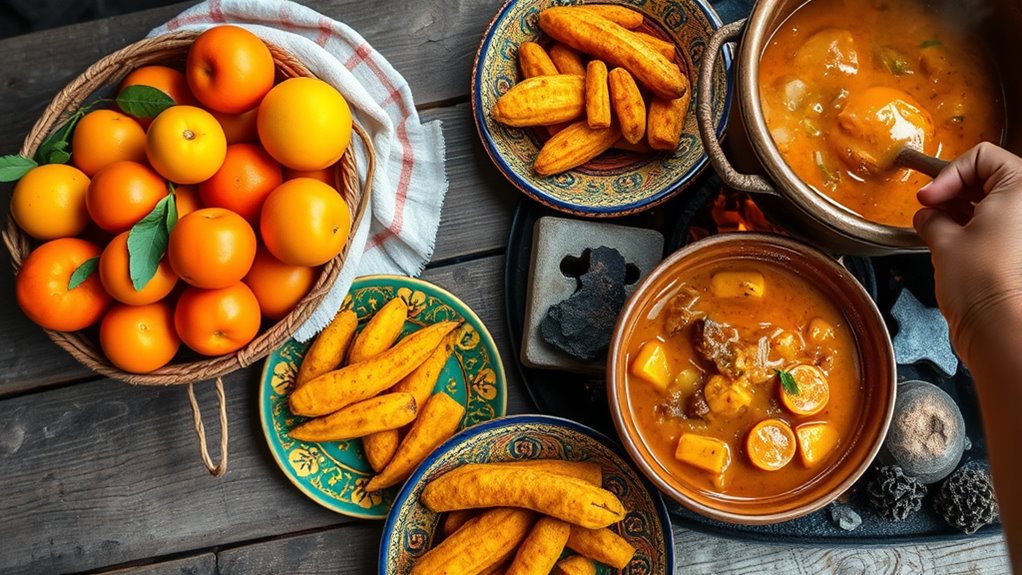
Traditional cooking techniques in Curaçao are deeply rooted in the island’s multicultural history and emphasize slow, communal, and resourceful methods. You’ll often find food prepared using open-flame grilling, boiling, and braising, which maximize flavor and tenderness. Stewing is common, especially for dishes like Kabritu Stoba, where goat meat is cooked gently with local spices and vegetables. Cooking is typically a shared activity, bringing families and communities together around large pots or outdoor fires. You’ll also notice the use of preservation techniques like marinating and smoking, which extend ingredient shelf life and enhance flavors. Making traditional bread like Pan Sera involves kneading and baking by hand, connecting you to generations of Curaçaoans. These practices reflect a resourceful, slow-paced approach that values flavor, community, and cultural heritage. Additionally, some cooks incorporate crochet techniques into their kitchen decor or food presentation, blending craft with culinary tradition to enrich the cultural experience.
The Vibrant Food Scene: Markets, Street Food, and Community Eateries
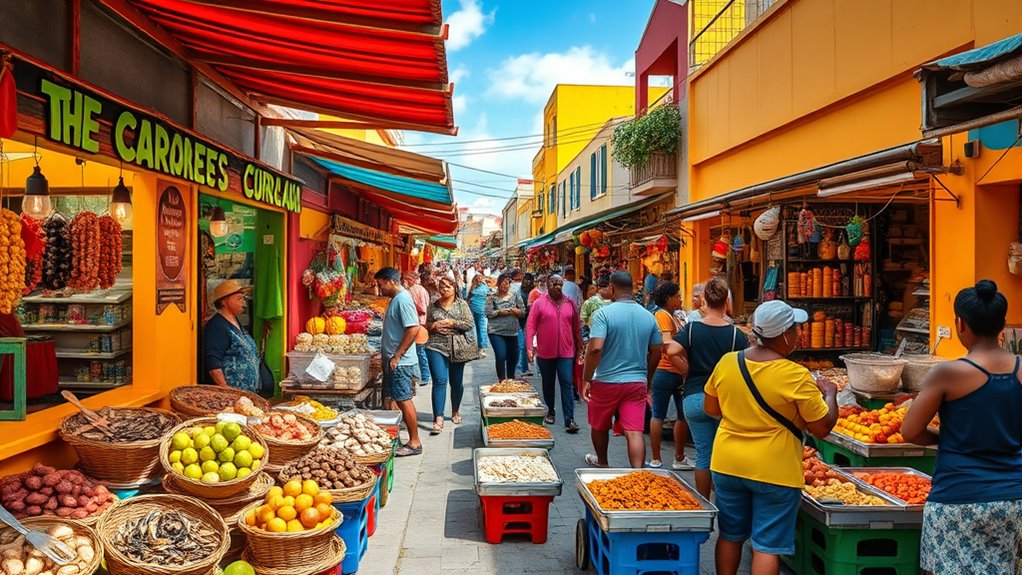
The lively food scene in Curaçao springs from its bustling markets, street vendors, and community eateries that bring people together around vibrant flavors and shared traditions. You’ll find fresh seafood, tropical fruits, and spicy snacks prepared right before your eyes. Markets like Plasa Bieu are social hubs where locals gather to enjoy hearty stews and fried treats. Street vendors serve up quick bites like pastechi (savory pastries), grilled seafood, and kuben (sweet coconut candies). Community eateries, often family-run, offer authentic dishes such as Keshi Yena and Kabritu Stoba. This scene captures Curaçao’s multicultural spirit, blending Caribbean, Dutch, and Latin influences into accessible, flavorful experiences. It’s where tradition, community, and flavor collide, creating an unforgettable culinary atmosphere.
Contemporary Twists: Modern Chefs and Fusion Creations
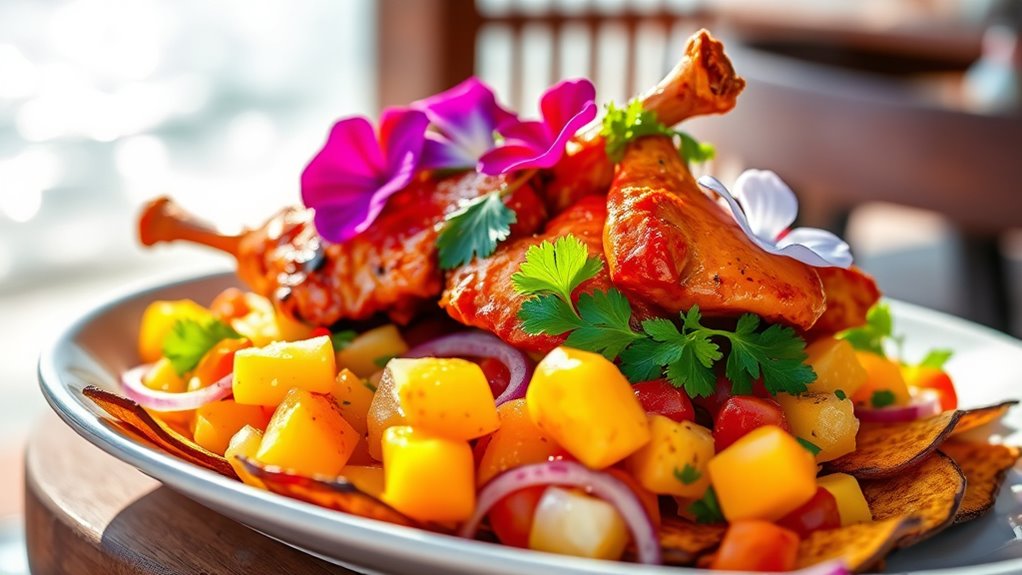
Modern chefs in Curaçao are redefining the island’s culinary scene by blending traditional flavors with innovative techniques and international influences. They experiment with local ingredients like fresh seafood, tropical fruits, and spices, creating dishes that honor heritage while pushing boundaries. Fusion cuisine plays a significant role, combining elements from Caribbean, Latin American, Asian, and European culinary traditions. For instance, you might find sushi-inspired seafood dishes with Curaçaoan spices or Caribbean-style tacos with locally sourced meats and tropical salsas. These chefs also incorporate edible flowers and modern plating techniques, elevating familiar dishes like Keshi Yena or Kabritu Stoba. Their creations showcase a vibrant, dynamic food culture that respects tradition but embraces contemporary trends, appealing to both locals and visitors seeking new culinary experiences. Embracing global culinary trends, many chefs are also exploring sustainable practices to promote local ingredients and eco-friendly sourcing.
The Role of Language and Heritage in Culinary Expression
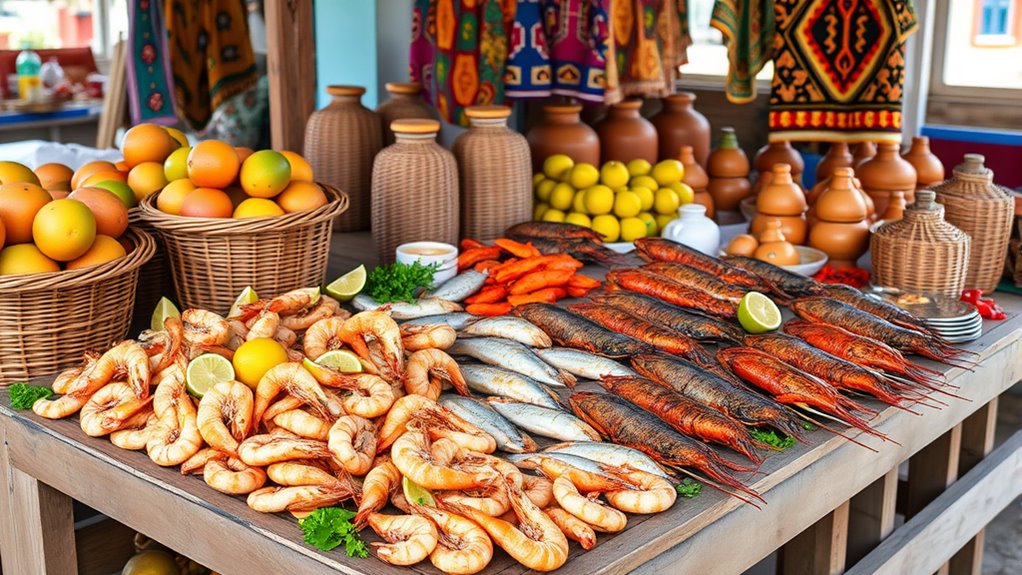
Language and heritage shape how Curaçaoans express their culinary identity, turning food into more than just sustenance. You’ll find that the island’s native language, Papiamentu, influences food names, descriptions, and conversations about meals, making cuisine a reflection of cultural pride. Words like “dushi” describe both tastes and the warmth of local hospitality, creating a shared sense of community. Heritage connects dishes to their roots, whether it’s Dutch influences in Keshi Yena or African traditions in Kabritu Stoba. By using language, locals preserve stories and customs, passing them through generations. Additionally, cultural preservation through culinary expressions helps maintain the island’s unique identity amid globalization.
Celebrations and Food: Special Dishes for Festivals and Gatherings
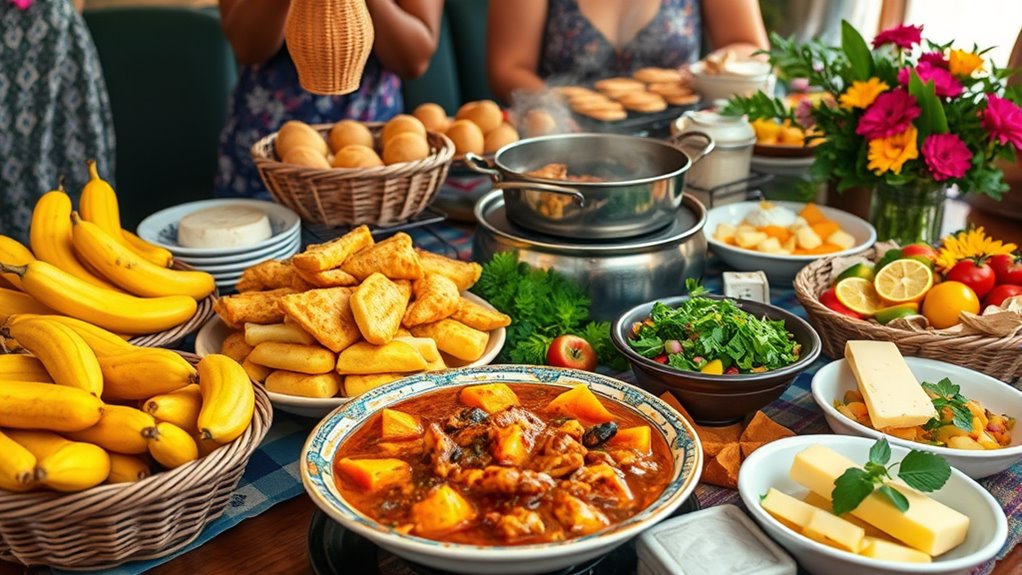
Celebrations and gatherings in Curaçao are lively occasions where food plays a central role, bringing people together to honor heritage and community. During festivals like Dia di San Juan or Carnival, you’ll find special dishes that symbolize cultural pride. Keshi Yena, a baked cheese with spiced meat, often appears at celebrations, showcasing Dutch-African fusion. Black Cake (Bolo Pretu), soaked in rum and packed with dried fruits, is a festive favorite for birthdays and holidays. Funchi and Tutu are staple side dishes served with hearty stews or seafood during communal feasts. Street parties and open markets buzz with the aroma of grilled seafood and tropical fruits. These dishes not only nourish but also reinforce connections, celebrating Curaçao’s rich, multicultural identity through shared culinary traditions. Incorporating attention to detail in preparing these dishes ensures authentic flavors and presentation that honor the island’s diverse heritage.
Preserving Heritage: Culinary Workshops, Recipes, and Cultural Pride
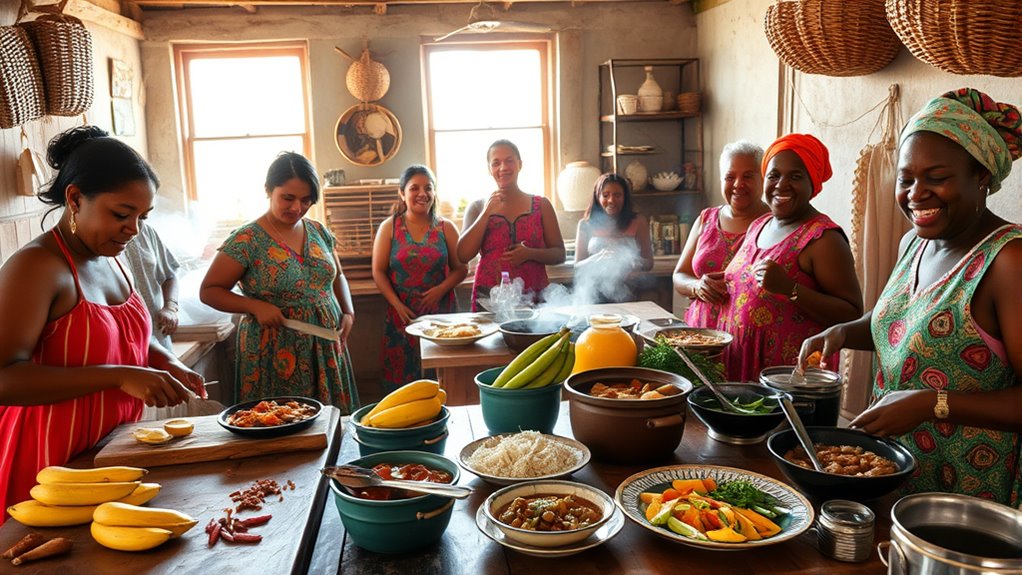
Culinary workshops and recipe collections play a vital role in preserving Curaçao’s rich food heritage, allowing locals and visitors alike to connect with the island’s traditions. By participating in these activities, you help keep age-old techniques and flavors alive. You can learn to make authentic dishes like Keshi Yena or Funchi, gaining insight into their cultural significance. These workshops also foster pride, strengthening community bonds and passing knowledge to future generations.
- Join local cooking classes focused on traditional recipes
- Share family recipes to keep culinary stories alive
- Support initiatives that celebrate Curaçaoan food history and culture
Frequently Asked Questions
How Does Papiamentu Influence Curaçaoan Food Naming and Descriptions?
You’ll notice that Papiamentu deeply influences Curaçaoan food naming and descriptions. When you hear locals talk about “dushi,” they’re expressing how delicious or good a dish tastes. Papiamentu words are often used to name traditional foods, making them feel more personal and rooted in culture. By using this language, you connect with the island’s history and community, making your culinary experience more authentic and meaningful.
What Role Do Edible Flowers Play in Modern Curaçaoan Cuisine?
Edible flowers play a growing role in modern Curaçaoan cuisine by adding vibrant colors, delicate flavors, and visual appeal to dishes. You might see beyísima or moringa used as garnishes in salads, desserts, or beverages, elevating traditional recipes with a touch of elegance. Chefs incorporate these flowers to connect with local nature, honor culinary artistry, and introduce unique flavor nuances that reflect the island’s creativity and environmental richness.
Are There Specific Traditional Drinks Paired With Curaçaoan Meals?
Ever wonder what drinks complement Curaçaoan meals? You’ll find that local beverages like “Sopi di Piska” (fish soup) are often paired with invigorating fruit juices made from tropical fruits like mango or papaya. Rum-based drinks, such as “Tula,” are also popular, especially during celebrations. These pairings enhance flavors, making your dining experience authentic and memorable. Do you want to taste the true essence of Curaçao?
How Do Indigenous Arawak Ingredients Feature in Current Dishes?
You’ll find indigenous Arawak ingredients in Curaçaoan dishes through the use of local plants, fruits, and spices. For example, you might taste moringa leaves in stews or enjoy edible flowers like beyísima for flavor and decoration. These ingredients add authentic, regional touches to traditional recipes, connecting you to the island’s roots. Chefs also incorporate native herbs and tropical fruits, celebrating Arawak heritage while creating vibrant, flavorful modern dishes.
What Are the Main Differences Between Street Food and Restaurant Cuisine in Curaçao?
You’ll notice street food in Curaçao is quick, affordable, and often served from open-air stalls or carts, emphasizing local flavors and casual dining. In contrast, restaurant cuisine tends to be more refined, with carefully plated dishes that showcase traditional ingredients and culinary techniques. Street food offers authentic, everyday eats like fried snacks and fresh seafood, while restaurants provide a broader menu, often blending traditional and contemporary influences for a sit-down dining experience.
Conclusion
Your journey through Curaçao’s vibrant culinary traditions reveals a rich tapestry of flavors, techniques, and cultural influences. From traditional dishes to modern fusions, the island’s food tells a story of heritage and innovation. As you savor these unique flavors, ask yourself—aren’t food and culture the true heartbeats of Curaçao? Embrace and preserve this culinary diversity, ensuring future generations continue to celebrate the island’s delicious legacy.

